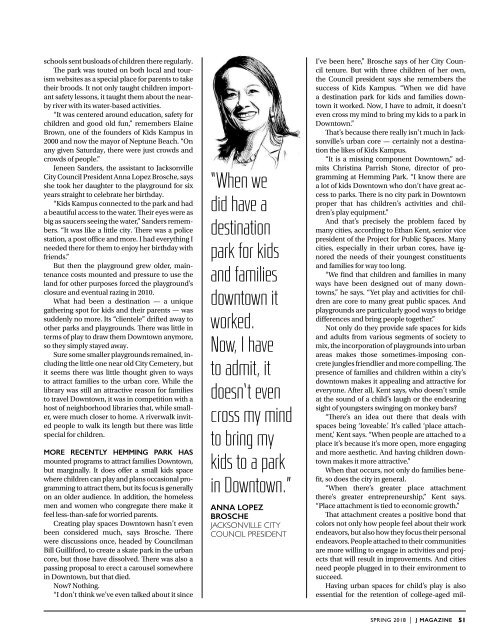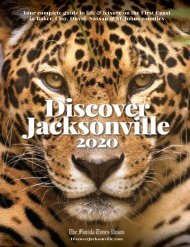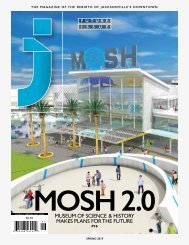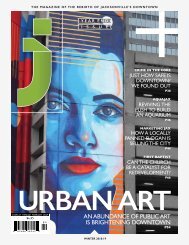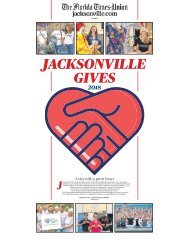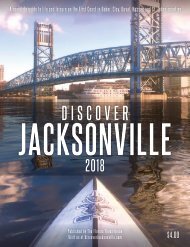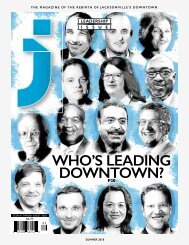J Magazine Spring 2018
Create successful ePaper yourself
Turn your PDF publications into a flip-book with our unique Google optimized e-Paper software.
schools sent busloads of children there regularly.<br />
The park was touted on both local and tourism<br />
websites as a special place for parents to take<br />
their broods. It not only taught children important<br />
safety lessons, it taught them about the nearby<br />
river with its water-based activities.<br />
“It was centered around education, safety for<br />
children and good old fun,” remembers Elaine<br />
Brown, one of the founders of Kids Kampus in<br />
2000 and now the mayor of Neptune Beach. “On<br />
any given Saturday, there were just crowds and<br />
crowds of people.”<br />
Jeneen Sanders, the assistant to Jacksonville<br />
City Council President Anna Lopez Brosche, says<br />
she took her daughter to the playground for six<br />
years straight to celebrate her birthday.<br />
“Kids Kampus connected to the park and had<br />
a beautiful access to the water. Their eyes were as<br />
big as saucers seeing the water,” Sanders remembers.<br />
“It was like a little city. There was a police<br />
station, a post office and more. I had everything I<br />
needed there for them to enjoy her birthday with<br />
friends.”<br />
But then the playground grew older, maintenance<br />
costs mounted and pressure to use the<br />
land for other purposes forced the playground’s<br />
closure and eventual razing in 2010.<br />
What had been a destination — a unique<br />
gathering spot for kids and their parents — was<br />
suddenly no more. Its “clientele” drifted away to<br />
other parks and playgrounds. There was little in<br />
terms of play to draw them Downtown anymore,<br />
so they simply stayed away.<br />
Sure some smaller playgrounds remained, including<br />
the little one near old City Cemetery, but<br />
it seems there was little thought given to ways<br />
to attract families to the urban core. While the<br />
library was still an attractive reason for families<br />
to travel Downtown, it was in competition with a<br />
host of neighborhood libraries that, while smaller,<br />
were much closer to home. A riverwalk invited<br />
people to walk its length but there was little<br />
special for children.<br />
MOre recently Hemming Park has<br />
mounted programs to attract families Downtown,<br />
but marginally. It does offer a small kids space<br />
where children can play and plans occasional programming<br />
to attract them, but its focus is generally<br />
on an older audience. In addition, the homeless<br />
men and women who congregate there make it<br />
feel less-than-safe for worried parents.<br />
Creating play spaces Downtown hasn’t even<br />
been considered much, says Brosche. There<br />
were discussions once, headed by Councilman<br />
Bill Guilliford, to create a skate park in the urban<br />
core, but those have dissolved. There was also a<br />
passing proposal to erect a carousel somewhere<br />
in Downtown, but that died.<br />
Now? Nothing.<br />
“I don’t think we’ve even talked about it since<br />
“When we<br />
did have a<br />
destination<br />
park for kids<br />
and families<br />
downtown it<br />
worked.<br />
Now, I have<br />
to admit, it<br />
doesn’t even<br />
cross my mind<br />
to bring my<br />
kids to a park<br />
in Downtown.”<br />
Anna Lopez<br />
Brosche<br />
Jacksonville City<br />
Council President<br />
I’ve been here,” Brosche says of her City Council<br />
tenure. But with three children of her own,<br />
the Council president says she remembers the<br />
success of Kids Kampus. “When we did have<br />
a destination park for kids and families downtown<br />
it worked. Now, I have to admit, it doesn’t<br />
even cross my mind to bring my kids to a park in<br />
Downtown.”<br />
That’s because there really isn’t much in Jacksonville’s<br />
urban core — certainly not a destination<br />
the likes of Kids Kampus.<br />
“It is a missing component Downtown,” admits<br />
Christina Parrish Stone, director of programming<br />
at Hemming Park. “I know there are<br />
a lot of kids Downtown who don’t have great access<br />
to parks. There is no city park in Downtown<br />
proper that has children’s activities and children’s<br />
play equipment.”<br />
And that’s precisely the problem faced by<br />
many cities, according to Ethan Kent, senior vice<br />
president of the Project for Public Spaces. Many<br />
cities, especially in their urban cores, have ignored<br />
the needs of their youngest constituents<br />
and families for way too long.<br />
“We find that children and families in many<br />
ways have been designed out of many downtowns,”<br />
he says. “Yet play and activities for children<br />
are core to many great public spaces. And<br />
playgrounds are particularly good ways to bridge<br />
differences and bring people together.”<br />
Not only do they provide safe spaces for kids<br />
and adults from various segments of society to<br />
mix, the incorporation of playgrounds into urban<br />
areas makes those sometimes-imposing concrete<br />
jungles friendlier and more compelling. The<br />
presence of families and children within a city’s<br />
downtown makes it appealing and attractive for<br />
everyone. After all, Kent says, who doesn’t smile<br />
at the sound of a child’s laugh or the endearing<br />
sight of youngsters swinging on monkey bars?<br />
“There’s an idea out there that deals with<br />
spaces being ‘loveable.’ It’s called ‘place attachment,’<br />
Kent says. “When people are attached to a<br />
place it’s because it’s more open, more engaging<br />
and more aesthetic. And having children downtown<br />
makes it more attractive.”<br />
When that occurs, not only do families benefit,<br />
so does the city in general.<br />
“When there’s greater place attachment<br />
there’s greater entrepreneurship,” Kent says.<br />
“Place attachment is tied to economic growth.”<br />
That attachment creates a positive bond that<br />
colors not only how people feel about their work<br />
endeavors, but also how they focus their personal<br />
endeavors. People attached to their communities<br />
are more willing to engage in activities and projects<br />
that will result in improvements. And cities<br />
need people plugged in to their environment to<br />
succeed.<br />
Having urban spaces for child’s play is also<br />
essential for the retention of college-aged mil-<br />
SPRING <strong>2018</strong> | J MAGAZINE 51


